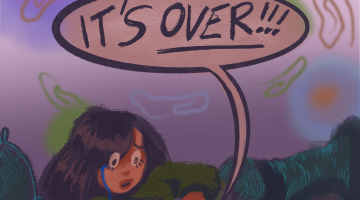
Image/The Nevada Sagebrush
“… What do you guys think?” asks the professor, staring at the rows of virtual students on screen. A thousand empty eyes stare back, black screens and frozen faces neatly stacked in rows like a field of dead grain. The silence lingers for an eternity, the only sound a faint murmur of a ceiling fan in the room of a student who refuses to mute their mic for some reason. Once again the teacher asks the abyss for an answer and receives none in return. Eons pass. Finally, bravery in the face of awkwardness wins out, and an answer is dared to be given: “khgjalkghladjgflksaflkasnglksanglhkgjlaksgj,” is what it sounds like, as two people try to answer at the same time. “No, wait, sorry, you go first,” the two voices echo in harmony as they both try to apologize at the exact same time. Neither wants to try and speak, a standoff occurs. Silence returns. In about twenty more decades, the professor will finally sort things out and an answer will be spoken. It will suck. It’s the wrong answer, but who cares? The class will move on. This is remote learning, but it doesn’t have to be.
It has been about two weeks of remote classes, and in almost none of my classes has an elegant solution been worked out regarding student participation. Last semester, since everything was so rushed, all of my professors simply didn’t try, and let the classes be completely silent–often letting the students turn the camera off while they lectured into the void. Honestly, this was better than what is going on now, where months of Zoom training has made professors bold enough to try things like asking students to speak answers into their microphones and using breakout rooms to foster cooperation. These things suck, they are awkward, heavily dependent on everyone having good mics, cameras, and internet connection, and never lead to the insightful moments that would occasionally happen when students participated during in-person classes and lectures. They should be done away with and abolished.
Have we forgotten the wisdom of our predecessors? Do we forget that before Zoom and Google Meet classes we spent the last ten or so years watching live-streams on Twitch, Facebook, and Youtube? In any one of those streams, do they let the audience have full power to vocalize their reactions simultaneously via microphone? Of course not! It is foolish to expect the level of coordination required to facilitate audience participation through mics and webcams in a non-awkward way from a bunch of non-professionals connected to low-quality wifi.
I propose a reform: let us do what other live-video services do, have the students respond in the chat while the professors hog the mic. There is a reason Twitch chat is such a successful way to promote audience interaction: it is decidedly not awkward. Multiple people can “talk” at the same time without tripping into each other. No one has to feel insecure about the way their voice might sound, or worry about being embarrassed by their audio quality. Even poor students stuck on their grandparent’s ancient internet can send a message through, and the professor can easily tell who-said-what when it is time to rifle through response. So please, professors, rethink the way you are hosting classes, and let your students shut up.
Vincent Rendon can be reached at vrendon@sagebrush.unr.edu or on Twitter @VinceSagebrush.










